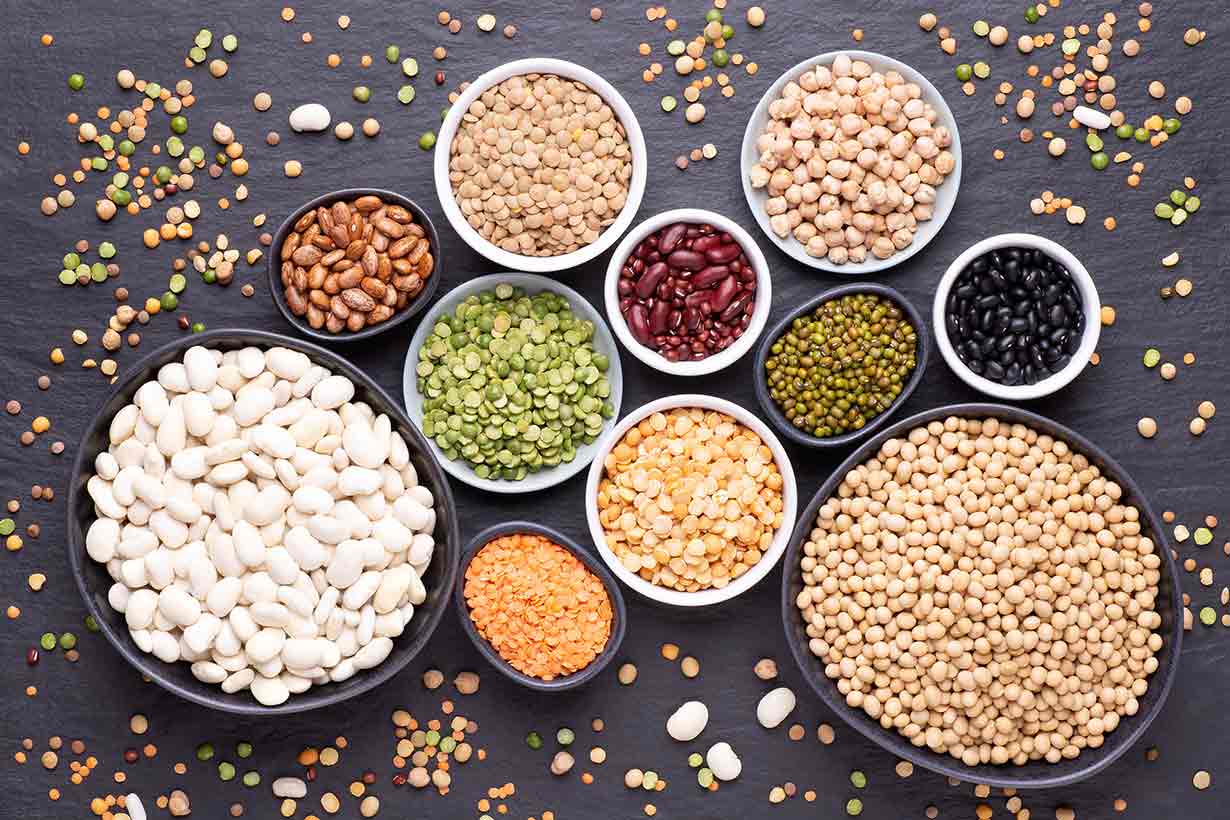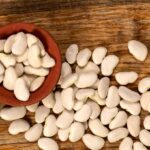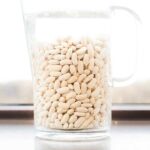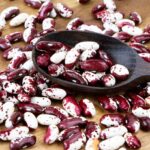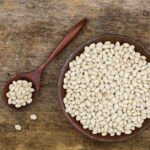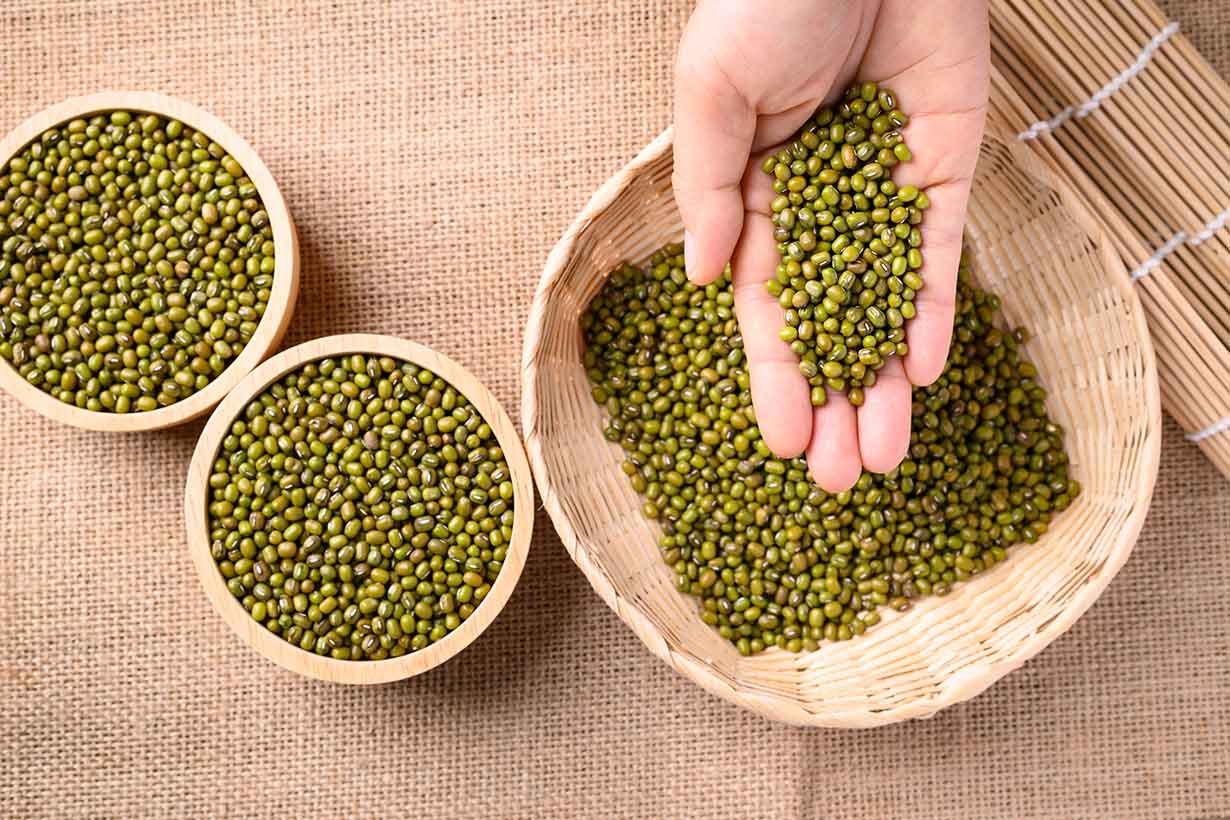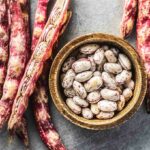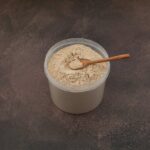Chickpeas are a nutritious legume variety that provides a rich source of protein and fiber.
These little beans are popular worldwide, and they feature in a range of different dishes due to their versatility.
This article provides an in-depth guide to chickpeas, their benefits, and their complete nutritional properties.
Table of contents
What Are Chickpeas?
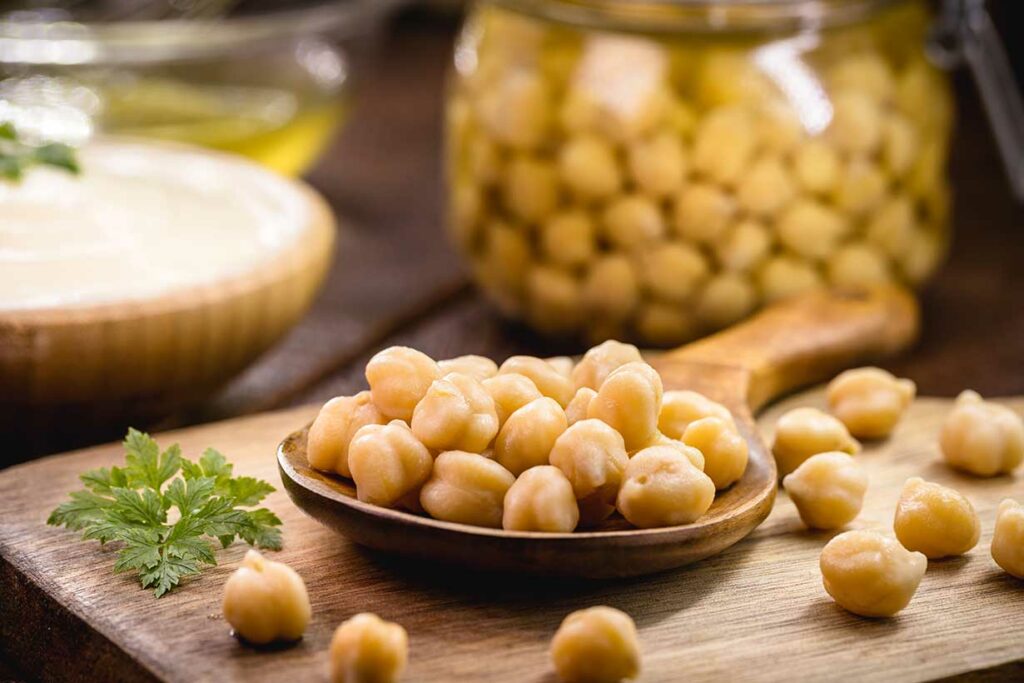
Chickpeas are also known as garbanzo beans, and they are a legume belonging to the Fabaceae family of plants (1).
The food term ‘legume’ refers to any edible part of the Fabaceae plant.
Chickpeas are a rich source of dietary protein and carbohydrates, and they provide a smaller amount of dietary fat.
Due to their use in many different recipes, perhaps most notably hummus, chickpeas are a popular food worldwide.
It is thought that ancient Turkey is the origin of chickpeas entering the human food chain. Interestingly, there is historical evidence of chickpea consumption in Turkey for thousands of years (2).
In more recent times, global production of chickpeas reached 15 million metric tons in the year 2020. Among the primary producers, India produced volumes many multiples larger than other countries producing the legume (3).
Behind soybeans and potentially peas, chickpeas rank as one of the highest-production legume crops (4).
Chickpeas have a slightly nutty flavor, but they are relatively mild like legumes such as lima beans and cannellini beans.
Benefits of Chickpeas
Based on the various nutrients and compounds chickpeas contain, they may have several benefits.
Here is a summary of some of their beneficial aspects.
1) Chickpeas Are High In Protein and Fiber
Chickpeas are one of the most protein-rich legumes.
In this regard, 100 grams of dried chickpeas contains 20.5 grams of protein (5).
Regarding cooked chickpeas, a cup (164-gram) serving supplies 14.5 grams of protein (6).
This protein content makes chickpeas one of the best plant-based protein options.
Note: soybeans and lupin beans offer the most protein for anyone interested in the highest plant-based protein sources.
Additionally, chickpeas provide a significant amount of fiber; a (cooked) cup serving provides 12.5 grams.
2) An Exceptional Source of Folate
Folate is an essential nutrient that plays numerous vital roles in the human body. Importantly, folate is a critical nutrient for a healthy pregnancy and preventing brain and spine birth defects, known as neural tube defects (7).
Aside from this, folate also has importance for DNA synthesis and methylation processes (8).
Due to its importance, poor folate status may raise the risk for numerous chronic diseases. Further, research does support an association between folate status and health outcomes.
There was a recent, extensive umbrella review of meta-analyses on folate and health outcomes published in the journal Frontiers in Public Health (9).
After analyzing data featuring 133 meta-analyses of observational studies and 154 meta-analyses of RCTs, the researchers noted an association between higher folate levels and lower risk of all-cause mortality. Furthermore, there were also associations between higher chickpea intake and reduced risk of various chronic diseases.
Dried chickpeas provide 557 mcg of folate per 100 grams, equal to 139% of the recommended daily value (5, 10).
Cooked weight, chickpeas offer 282 mcg of folate per cup (164g) serving, equal to 71% of the daily value (6, 10).
3) Chickpeas Provide a Broad Range of Essential Nutrients
On a per-100-gram basis, a cup (164-gram) serving of cooked chickpeas provides more than 10% of the daily value for the following vitamins and minerals (6, 10):
- Manganese
- Folate
- Copper
- Iron
- Zinc
- Phosphorus
- Magnesium
- Vitamin B6
- Choline
- Selenium
- Potassium
As we can see from this list, a serving of chickpeas would contribute a significant amount of beneficial nutrients to the average diet.
4) May Benefit Cardiovascular Health
Numerous systematic reviews and meta-analyses of observational research have found associations between legume intake and a lower risk of cardiovascular disease (11, 12, 13).
Aside from the nutritional content of legumes, mechanisms for this potential benefit include the bioactive compounds that legumes contain, such as bioactive peptides and polyphenols (14).
A randomized controlled trial specifically on chickpeas also found that their intake may lower cardiovascular risk markers (15).
This particular study featured forty-seven adults, split into groups whose (closely matched) diets were supplemented daily with either:
- 140 grams of canned and drained chickpeas, alongside bread and shortbread made with 30% chickpea flour.
- Wholemeal wheat bread, high-fiber wheat breakfast cereals, and shortbread biscuits.
Participants took blood tests before and after the study.
After consuming these diets daily for five weeks, the participants had blood tests taken and then switched to the opposing diet for five weeks.
At the end of the study, the results demonstrated that participants consuming the chickpea diet had 5.0% lower total cholesterol and 4.3% lower LDL cholesterol than the wheat group (15).
Higher LDL (low-density lipoprotein) cholesterol levels are strongly and consistently associated with increased cardiovascular risk (16).
Thus, if chickpeas help lower LDL levels, they may help reduce cardiovascular risk.
5) Chickpeas Are a Versatile Ingredient
One of the most beneficial aspects of chickpeas is that they are versatile and have many culinary uses.
For instance, we can use chickpeas to make dips such as hummus, roast them in the oven, mix them into curries, and even soups and salads.
There are multiple ways to use chickpeas, and they always seem to absorb the flavors of the foods they mix with.
Among the various world cuisines which use chickpeas, they are particularly popular in Indian and Middle-Eastern cuisine.
It’s even possible to find ‘high-protein pasta’ made with chickpeas. For more on this, see this guide to legume pasta.
Full Nutrition Facts
The following data shows the full nutritional values for boiled chickpeas per standard cup (164-gram) serving.
All nutritional data is sourced from the USDA’s FoodData Central database (6).
Daily values have been calculated using the USDA data alongside the FDA’s published daily values (10).
| Name | Amount | % Daily Value (DV) |
|---|---|---|
| Calories | 269 kcal | |
| Carbohydrates | 44.9g | 16% DV |
| Fiber | 12.5g | 45% DV |
| Sugars | 7.87g | |
| Fat | 4.25g | 5% DV |
| Saturated | 0.44g | 2% DV |
| Monounsaturated | 0.96g | |
| Polyunsaturated | 1.9g | |
| Omega-3 | 0.07g | |
| Omega-6 | 0.96g | |
| Protein | 14.5g | 29% DV |
The basic nutritional values of chickpeas are fairly similar to adzuki beans; they have very similar carbohydrate, fiber, and protein content.
However, chickpeas contain slightly higher amounts of fat.
Vitamins
- Folate: 71% of the daily value
- Thiamin (B1): 16% DV
- Vitamin B6: 13% DV
- Choline: 13% DV
- Pantothenic acid (B5): 9% DV
- Riboflavin (B2): 8% DV
- Niacin (B3): 5% DV
- Vitamin K: 5% DV
- Vitamin C: 2% DV
- Vitamin A RAE: <1% DV
- Vitamin B12: 0% DV
- Vitamin E: 0% DV
- Vitamin D: 0% DV
Minerals
- Manganese: 73% DV
- Copper: 64% of the daily value
- Iron: 26% DV
- Zinc: 23% DV
- Phosphorus: 22% DV
- Magnesium: 19% DV
- Selenium: 11% DV
- Potassium: 10% DV
- Calcium: 6% DV
- Sodium: <1% DV
Amino Acid Composition
The protein component of food is made up of different amino acids.
Again based on USDA data, here is the amino acid composition of chickpeas (5, 6):
| Amino Acid | Per 100g Dry Weight | Per 164g cup Cooked Weight |
|---|---|---|
| Tryptophan | 0.2g | 0.139g |
| Threonine | 0.766g | 0.54g |
| Isoleucine | 0.882g | 0.623g |
| Leucine | 1.46g | 1.04g |
| Lysine | 1.38g | 0.973g |
| Methionine | 0.27g | 0.19g |
| Cystine | 0.279g | 0.195g |
| Phenylalanine | 1.1g | 0.779g |
| Tyrosine | 0.512g | 0.361g |
| Valine | 0.865g | 0.61g |
| Arginine | 1.94g | 1.37g |
| Histidine | 0.566g | 0.4g |
| Alanine | 0.882g | 0.623g |
| Aspartic acid | 2.42g | 1.71g |
| Glutamic acid | 3.6g | 2.54g |
| Glycine | 0.857g | 0.605g |
| Proline | 0.849g | 0.6g |
| Serine | 1.04g | 0.773g |
The table shows that chickpeas contain all essential amino acids (EAA) – histidine, isoleucine, leucine, lysine, methionine, phenylalanine, threonine, tryptophan, and valine.
However, the methionine content is relatively low, making it the limiting amino acid.
A ‘limiting amino acid’ is the EAA in the lowest amount, since a deficient level of an EAA will prevent further protein synthesis. Therefore, if a diet is strictly plant-based, it is crucial to consume different sources of plant proteins.
In this regard, grains, nuts, and seeds all have higher methionine content than chickpeas.
In contrast, grains, nuts, and seeds are lower in lysine than chickpeas.
Glycemic Index
The glycemic index is a numbered system, from 0 to 100, used to predict how much a particular food will increase blood sugar levels.
According to the International Tables of Glycemic Index and Glycemic Load Values, published in 2008, chickpeas have a glycemic index of 28 (17).
Bioactive Compounds
Aside from the carbohydrate, fat, protein, vitamin, and mineral content of chickpeas, they also contain various bioactive compounds.
In other words, compounds that have biological effects within the human body.
Researchers believe these compounds may benefit human health. However, research in the area is in its relative infancy.
Among these bioactive compounds, chickpeas contain:
Differences Between Dried and Canned Chickpeas
There are no significant nutritional differences between dried and canned chickpeas.
The main differences come down to preparation time and expense.
For instance, cooking dried chickpeas from their raw state takes relatively long, yet dried chickpeas are very cheap.
On the other hand, canned chickpeas have already been cooked and only need reheating. However, they are understandably more expensive gram for gram.
There is a guide to cooking dried chickpeas here. The least time-consuming method takes approximately one hour.
How To Use Chickpeas
One of the best things about chickpeas is that they are very versatile and absorb flavors well.
Here are some ideas on how to use them, ranging from the very simple to more ambitious ideas:
- The simplest: cook the chickpeas, sprinkle some seasonings of choice on top, and eat them on their own.
- Salad: mix cooked chickpeas with finely chopped celery, bell peppers, tomato, cucumber, and red onions. Add a dressing with olive oil, lemon juice, mustard, salt, and pepper, and mix everything.
- Roasted: use cooked (or canned) chickpeas and marinate them in olive oil, curry powder, salt, and black pepper. Then roast them in the oven at 200°C (392°F) for approximately 30 minutes, or until they have started to brown.
- In curries: add chickpeas to a favorite curry – they will absorb the flavors in a similar way to rice.
- Soups and stews: add pre-cooked (or canned) chickpeas to soups and stews for the last ten minutes.
- Hummus: have a go at trying to make some homemade hummus.
Final Thoughts
Chickpeas are nutritious and versatile legumes, and there are multiple ways to add them to a diet.
They provide a good range of nutrients, may have some health benefits, and taste great when prepared correctly.

